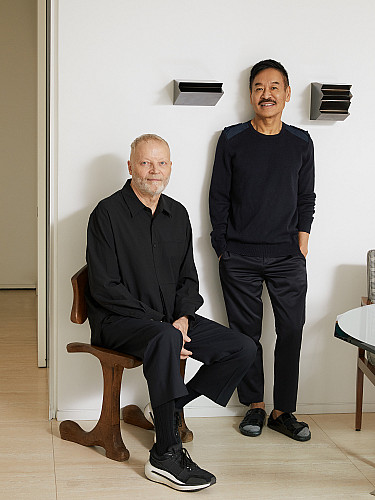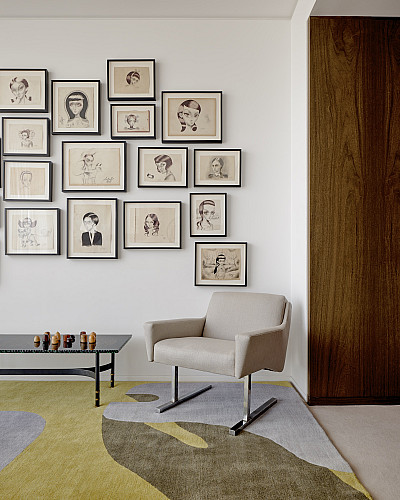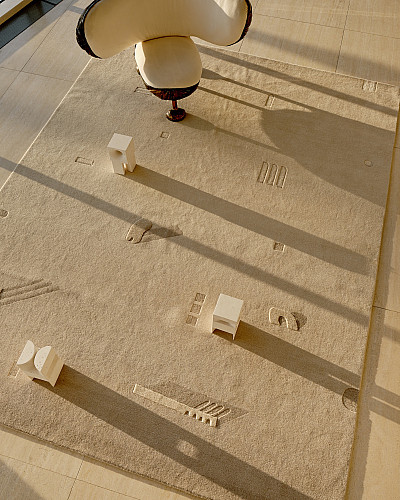[ad_1]
Spaces
Text by Mallika Chandra. Photographs courtesy Sean Davidson | Yabu Pushelberg


Left to Right: Dome rug; Glenn Pushelberg and George Yabu
Inspired by the idea of “impossible structures” that were exclusively created for Montreal’s Expo 67, Yabu Pushelberg — the multidisciplinary practice founded by George Yabu and Glenn Pushelberg — developed the forms for Memento. In this limited series of art pieces that was unveiled recently, the international design studio, that has offices in New York and Toronto, referenced the experimental output of the decades-old expo. The designers then selected memories and experiences that continuously inform their studio practice — from ’20s expressionist films to a meal made and shared with loved ones — and fused them with the initial reference to create contemporary pieces.
Through their two-year-long collaboration with Yabu Pushelberg for this collection, cc-tapis — founded by Nelcya Chamszadeh and Fabrizio Cantoni, and led by Daniele Lora, art director and partner — explored several different techniques and materials in their atelier in Nepal. The Milan-based rug-maker prides itself in bringing a contemporary approach to traditional methods and the rugs that emerged from this process are a testament to the ancient craft of the Tibetan artisans who cc-tapis works with. For Memento — they have combined both dyed and undyed materials, and produced some of the softest finishes. George Yabu, in fact, has particularly professed his love for the four undyed pieces from Memento — Axo, Iso, Ortho and Drift — because the subtly varying tones achieved were created not only during the handmade processes but were also influenced by the completely natural environment of valleys and mountains inhabited by the specific herd of sheep whose wool was used.

Iso rug
Edited excerpts from an interaction with the collaborators:
As evident in the title Memento, the collection is deeply inspired by memory. To what extent do your personal narratives find a place in your creative process and the final outcome?
Glenn Pushelberg (GP): Everything we touch or do begins with a dance of ideas that orchestrates a vision. We always like to start with a story — and that enables us to produce a clear purpose and emotion. Personal narratives are interwoven into everything we do; they comprise the essence of the studio and take us forward. In that way, everything we design is both simultaneously informed by memories and narratives and the future, thus creating an ecosystem of thinking and communicating.
These stories can be distilled from the smallest of things — from the wind stroking a curtain in a restaurant in Bangkok, to a tile we come across on a street, or a meal made with loved ones. What really inspires us is listening to the earth and connecting with people so that we can build worlds that make sense and are attuned to their needs and their futures.


Left to Right: Echo rug; Laneway rug
Can you tell us about some of the memories that came up during the design process? Which were the moments or spaces that you revisited?
George Yabu (GY): The 1920’s expressionist film The Cabinet of Dr Caligari influenced both me and Glenn. I remember being mesmerised by it in my university film critique class and watching it again on my own. I was initially drawn to its fragmented, geometric angles and perspectives. And to this day it has remained in our minds and we often go back to it and reference it.
The idea behind Memento originated from the idea of “impossible architecture” and the fantastical structures that were created for Montreal’s Expo 67. The event remains significant to me in many ways. This world fair was 1000 per cent rooted in the experimental and it remained pure because it was a pop-up that was not intended to last forever. This happened before “pop-up” became a term. Its notions spiralled into the 3D forms that became the visual signifiers of the ‘Memento’ collection.
What are some of the key innovations — big or small — in this collection? How have Yabu Pushelberg married their sensibilities with the materiality that cc-tapis has come to be known for?
Daniele Lora: The main challenge in the development of the collection was the recreation of the delicate gradients imagined and designed by the North American design studio. We developed and produced several prototypes experimenting with different techniques and materials to translate the extremely delicate gradients into new aesthetics. Guided by a contemporary approach to traditional methods, our artisans combined both dyed and undyed materials to create seven unique hand-made pieces which evoke Yabu Pushelberg’s soft and undefined nostalgic moments that find an expression in the collection.

Drift rug
How has colour, or the lack of it — as in the undyed pieces — played a role in creating this collection?
GY: Undyed pieces are a fun surprise because they’re based on the breed of sheep that happened to walk by and needed their wool to be shaved at the time. What did the sheep eat? Were they from the valley or from the mountains? All these components impact the look of the undyed wool, which is what we love about it.
Today, the world is bathed in saturated Technicolor. We live in an HD (high-definition) world which is vivid and hyperreal, where technology allows the expression of spaces, of forms and colours in a more immediate way. But when you think of images of memories from the past, they were not as kinetic. So, colours stand out less to me personally when I go back into my memories and we wanted to bring that into the collection.
[ad_2]
Source link
Jarastyle – #Knotting #Future
Courtesy : https://www.vervemagazine.in/travel-and-spaces/knotting-the-past-with-the-future

